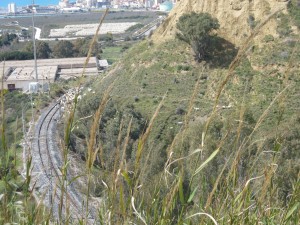
Here’s the view of the small valley below the path that cuts from Pirandello’s childhood house to the garden and boulder where ashes lie (and the ashes of some other Italians, as tells Prof. Gavioli interesting story). It was looking out over the valley, walking back to the bus after visiting the tomb, that we saw a flock of sheep being herded by two pastors—one in the front and one in the back (this one can barely be made out in the picture)—through the small grassy hillside and past a set of railroad tracks into the distance. I was naturally impressed by the scene because it was the first time I’d seen the herding of a flock, and it stuck with me even more because it contrasted in several ways to the rather Biblical images I have of shepherding: the shepherds were dressed like normal civilians; the backdrop was not some idyllic landscape but not-too-distant rows of high-rise buildings in either direction, in the picture’s backdrop and behind us on the path; and the sheep, even the last few stragglers, continued over the railroad tracks as if it were pasture. In mind were the Italian class’s talk about the conflict between civilized modernization in which northern Italy prides itself and the more rural life of southern Italy: I could see the conflict physically manifested before me and how, just as the sheep and shepherds went on, life seems to go on despite or alongside the intrusion of new things. Fresh in mind, too, were some of the lines in Book V of the Aeneid, and I could imagine these two young pastors as a couple of the many Sicilian youth from the countryside who, eager for pride, entered the footrace sponsored by Aeneas.